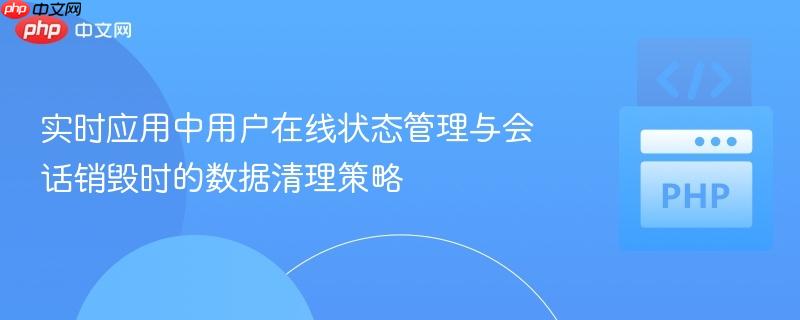
在实时应用中,准确追踪用户在线状态并在会话结束时清理相关数据是一个常见挑战。本文将探讨如何解决当用户直接关闭浏览器而非正常登出时,服务器端难以感知并及时更新在线用户列表的问题。我们将深入分析基于websockets的实时解决方案和基于ajax周期性心跳检测的传统方法,并提供实现思路与注意事项,确保用户状态的准确性与数据一致性。
在构建聊天应用等实时系统时,通常需要维护一个“在线用户列表”(例如存储在数据库的 activeuserlist 表中)。当用户登录时,将其添加到此列表;当用户登出时,将其移除。然而,一个普遍的难题是,当用户直接关闭浏览器窗口或标签页时,服务器端并不能立即感知到这一行为。PHP的会话(session)机制通常依赖于会话过期或用户主动销毁,而浏览器关闭并不会直接触发服务器端的会话销毁事件,导致 activeuserlist 中可能残留已下线用户的数据,影响在线状态的准确性。
要解决这个核心问题,关键在于如何可靠地检测到客户端与服务器的连接断开。
WebSockets 提供了一种在客户端和服务器之间建立持久双向连接的能力。这是处理实时用户状态最推荐和最有效的方法。
以PHP为例,可以使用如 Ratchet 这样的库来构建 WebSocket 服务器。
WebSocket 服务器端 (PHP - Ratchet)
// server.php
require dirname(__DIR__) . '/vendor/autoload.php';
use Ratchet\MessageComponentInterface;
use Ratchet\ConnectionInterface;
use Ratchet\Server\IoServer;
use Ratchet\Http\HttpServer;
use Ratchet\WebSocket\WsServer;
class Chat implements MessageComponentInterface {
protected $clients;
protected $activeUsers; // 存储 ConnectionInterface 和用户ID的映射
public function __construct() {
$this->clients = new \SplObjectStorage;
$this->activeUsers = [];
}
public function onOpen(ConnectionInterface $conn) {
$this->clients->attach($conn);
echo "New connection! ({$conn->resourceId})\n";
// 在此处可以进行用户认证,并将用户ID与$conn关联
// 例如:$conn->userId = $authenticatedUserId;
// 假设已通过某种方式获取到用户ID
// $this->activeUsers[$conn->resourceId] = $conn->userId;
// 数据库操作:将用户ID添加到 activeuserlist
// $this->addToActiveUserList($conn->userId);
}
public function onMessage(ConnectionInterface $from, $msg) {
// 处理消息,例如广播给其他用户
// ...
}
public function onClose(ConnectionInterface $conn) {
$this->clients->detach($conn);
echo "Connection {$conn->resourceId} has disconnected\n";
// 获取断开连接的用户ID
// $userId = $this->activeUsers[$conn->resourceId] ?? null;
// if ($userId) {
// 数据库操作:从 activeuserlist 中移除该用户ID
// $this->removeFromActiveUserList($userId);
// unset($this->activeUsers[$conn->resourceId]);
// }
}
public function onError(ConnectionInterface $conn, \Exception $e) {
echo "An error has occurred: {$e->getMessage()}\n";
$conn->close();
}
// 辅助函数,用于数据库操作(需要替换为实际的数据库连接和操作)
// private function addToActiveUserList($userId) {
// // INSERT INTO activeuserlist (user_id, status) VALUES (:userId, 'online');
// }
// private function removeFromActiveUserList($userId) {
// // DELETE FROM activeuserlist WHERE user_id = :userId;
// }
}
$server = IoServer::factory(
new HttpServer(
new WsServer(
new Chat()
)
),
8080 // WebSocket 端口
);
$server->run();客户端 (JavaScript)
// client.js
var conn = new WebSocket('ws://localhost:8080');
conn.onopen = function(e) {
console.log("Connection established!");
// 可以在这里发送用户认证信息给服务器
// conn.send(JSON.stringify({ type: 'auth', userId: currentUserId }));
};
conn.onmessage = function(e) {
console.log(e.data);
};
conn.onclose = function(e) {
console.log("Connection closed!");
// 可以在这里处理连接断开后的客户端逻辑
};
conn.onerror = function(e) {
console.error("WebSocket Error: ", e);
};如果无法使用 WebSocket,可以通过周期性的 AJAX 请求来模拟心跳检测,以判断用户是否仍然在线。
客户端 (JavaScript)
// client.js
function sendHeartbeat() {
fetch('/api/heartbeat.php', {
method: 'POST',
headers: {
'Content-Type': 'application/json',
// 可以包含认证信息,例如Session ID或Token
},
body: JSON.stringify({ userId: currentUserId }) // 假设currentUserId已定义
})
.then(response => response.json())
.then(data => {
if (data.status === 'success') {
console.log('Heartbeat sent successfully.');
} else {
console.error('Heartbeat failed:', data.message);
}
})
.catch(error => {
console.error('Error sending heartbeat:', error);
});
}
// 每隔 30 秒发送一次心跳
setInterval(sendHeartbeat, 30 * 1000);
// 页面关闭或刷新时尝试发送一个最终的心跳或通知
window.addEventListener('beforeunload', function() {
// 理论上,可以在这里发一个同步请求通知下线,但实际操作中不推荐,因为会阻塞页面关闭
// 且浏览器可能阻止同步XHR在beforeunload中发送
// 更好的方式是依赖服务器端的超时清理机制
});服务器端 (PHP - api/heartbeat.php)
<?php
// heartbeat.php
header('Content-Type: application/json');
// 假设已建立数据库连接 $pdo
$pdo = new PDO('mysql:host=localhost;dbname=your_db', 'user', 'password');
$pdo->setAttribute(PDO::ATTR_ERRMODE, PDO::ERRMODE_EXCEPTION);
// 获取用户ID (从session或POST数据中获取,这里简化为POST)
$input = json_decode(file_get_contents('php://input'), true);
$userId = $input['userId'] ?? null;
if (!$userId) {
echo json_encode(['status' => 'error', 'message' => 'User ID is required.']);
exit;
}
try {
// 更新用户的最后活跃时间
$stmt = $pdo->prepare("INSERT INTO activeuserlist (user_id, last_active_time) VALUES (:userId, NOW()) ON DUPLICATE KEY UPDATE last_active_time = NOW()");
$stmt->execute([':userId' => $userId]);
echo json_encode(['status' => 'success', 'message' => 'Heartbeat updated.']);
} catch (PDOException $e) {
echo json_encode(['status' => 'error', 'message' => 'Database error: ' . $e->getMessage()]);
}
// 清理离线用户的函数 (可以在这里调用,或由定时任务调用)
function cleanupInactiveUsers($pdo, $timeoutMinutes = 5) {
$stmt = $pdo->prepare("DELETE FROM activeuserlist WHERE last_active_time < NOW() - INTERVAL :timeoutMinutes MINUTE");
$stmt->execute([':timeoutMinutes' => $timeoutMinutes]);
return $stmt->rowCount();
}
// 可以在每次心跳请求后尝试清理,但更推荐使用Cron Job
// cleanupInactiveUsers($pdo, 5);
?>服务器端 (Cron Job - 概念性)
# 每隔5分钟执行一次PHP脚本来清理离线用户 */5 * * * * /usr/bin/php /path/to/your/cleanup_script.php
cleanup_script.php
<?php
// cleanup_script.php
$pdo = new PDO('mysql:host=localhost;dbname=your_db', 'user', 'password');
$pdo->setAttribute(PDO::ATTR_ERRMODE, PDO::ERRMODE_EXCEPTION);
$timeoutMinutes = 5; // 定义离线超时时间
$stmt = $pdo->prepare("DELETE FROM activeuserlist WHERE last_active_time < NOW() - INTERVAL :timeoutMinutes MINUTE");
$stmt->execute([':timeoutMinutes' => $timeoutMinutes]);
echo "Cleaned up " . $stmt->rowCount() . " inactive users.\n";
?>管理实时应用中的用户在线状态,并在会话非正常终止时进行数据清理,是提升用户体验和数据准确性的关键。WebSockets 提供了一种高性能、高实时性的解决方案,但增加了架构复杂性。周期性 AJAX 心跳检测则是一种更传统、易于实现的方案,但牺牲了实时性和服务器效率。
在选择方案时,应根据应用的实时性要求、用户规模、开发团队的技术栈和资源投入来权衡。对于需要高度实时性的聊天或协作应用,WebSockets 是首选;而对于实时性要求不那么严格的应用,或者作为过渡方案,AJAX 心跳检测也是一个可行的选择。无论选择哪种方法,都应注重数据一致性、性能优化和健壮性设计。
以上就是实时应用中用户在线状态管理与会话销毁时的数据清理策略的详细内容,更多请关注php中文网其它相关文章!

每个人都需要一台速度更快、更稳定的 PC。随着时间的推移,垃圾文件、旧注册表数据和不必要的后台进程会占用资源并降低性能。幸运的是,许多工具可以让 Windows 保持平稳运行。

Copyright 2014-2025 https://www.php.cn/ All Rights Reserved | php.cn | 湘ICP备2023035733号